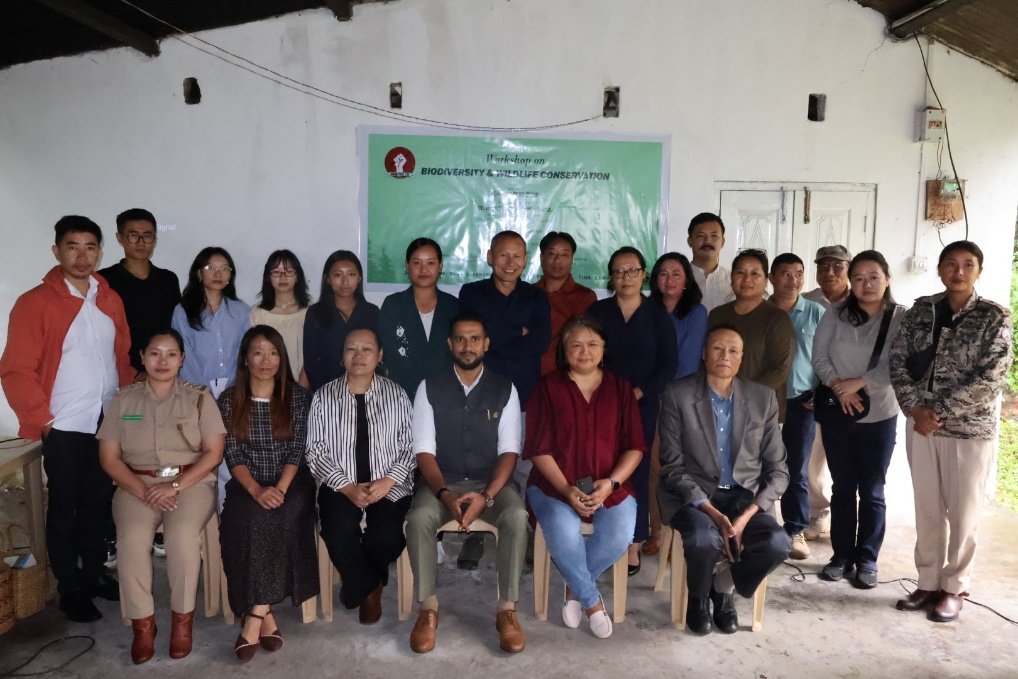The Kohima Press Club (KPC) on Saturday organised a one-day workshop on biodiversity and wildlife conservation in collaboration with the Silviculture Division Kohima. The workshop is one of the activities being organised as part of the yearlong celebration of the 25th Anniversary of KPC envisioned to help equip the Press Club members with more knowledge on biodiversity conservation efforts in the state and help media professionals to effectively report on biodiversity-related issues.
Wildlife Conservation Society (WCS)– India project lead and veteran journalist Bano Haralu, who was one of the resource speakers at the workshop underscored that conversations surrounding conservation are often associated with policies, governance, economy or funds, while it is really the people/communities who are at the heart of conservation.
She said conservation is directly related to the access that people have to nutrition, good water, good livelihood, and healthy lifestyle. Stating that people are at the heart of all these, she emphasised the need to look at these things more closely.
Pointing out that the most crucial things that need support get the least funding, Haralu stated that so much emphasis is being given on creating new infrastructure. She observed that Nagaland being over 60 years old as a state should be maintaining and improving its existing infrastructure, not building new ones rampantly further destroying the environment.
She also highlighted that the state has lost so much forest cover in the recent years due to developmental activities, but she also attributes part of it to unregulated hunting as regrowth of forest cannot happen without wildlife.
Haralu also expressed concern over the diminishing traditional knowledge, maintaining that the value that “our ancestors” once gave to ecological and traditional knowledge and stories have now been replaced by schools and textbooks. Towards this, she stressed on the importance and the need for the younger generation to connect with their culture and traditions, saying that indigenous knowledge is deeply-rooted in the soil.
She urged upon young journalists to go beyond press releases and greenwashed events, and look at issues that are directly affecting the ecology, citing the deforestation in the name of development activities including construction of roads, bridges, rampant quarrying etc.
Haralu also highlighted that one of the major attributes to biodiversity loss in Nagaland is monoculture. She stated that teak plantation was introduced to the state’s pristine forests; then came rubber plantation; and now the government is “audaciously” introducing oil palm, which she observes, will not only cause harm to the state’s biodiversity but also poses a demographic threat as well since the cultivation of oil palm needs a lot of manual work which the Naga people are not ready to do by themselves.
Download Nagaland Tribune app on Google Play

Member of Indigenous People & Local Communities (IP&LC) Advisory Board, WCS-International, and chairman Sendenyu Community Biodiversity and Wildlife Conservation Board, Gwasinlo Thong told members of the Kohima Press Club that as journalists, their narratives matter and it is what the society will believe.
“Your narratives should always be for the good of the people, for the good of the society and the future generations… You can play a pivotal role in bringing the right change in the society,” he said.
Speaking on the topic “Community Biodiversity & Wildlife Conservation”, Thong, who has spearheaded the community conservation efforts of Sendenyu village under Tseminyu district for the past 25 years, shared the challenges in bringing together communities to change their way of life and their livelihood towards more eco-friendly practices.
“We have millions of challenges. But the most immediate challenge we have today is the ecological and environmental issues, where if we don’t act now, it may be too late,” he said.
He spoke about how the traditional Naga way of life revolved around biodiversity, relating stories of Naga ancestors who were in-tune with nature and cultivated the land without disturbing the ecological balance.
Stating that the complexities of climate change were never known to the ancestors, he said they were somehow able to intuitively maintain a perfect ecological balance in their surroundings.
Highlighting Sendenyu village and community’s journey of 25 years of efforts in conservation, he said the results are few yet encouraging. The village strictly maintains a 20 Sq. Km. of its area for in-situ preservation of flora and fauna. Thong narrated challenges in convincing the villagers to give up age-old practice of hunting and jhum cultivation which were detrimental to biodiversity. He said the village community has reluctantly but successfully moved forward and 90% of the villagers are now engaged in wet terrace cultivation and horticulture.
The Sendenyu community biodiversity and wildlife conservation efforts is known for its pioneering example in creating the first biodiversity education centre in the state.
State Silviculturist Dr. Prabhat Kumar, who also spoke at the event advocated for meaningful conservation, while discouraging superficial once-a-year plantation drives. He asserted that the reason why poeple should conserve is because it is the right thing to do.
The official maintained that the media carry huge responsibility and has the power to control the flow of information in the right manner, especially when it comes to awareness. Towards this, he lauded the KPC for organising the workshop to orient its members on the realities/facts surrounding biodiversity and its conservation.

